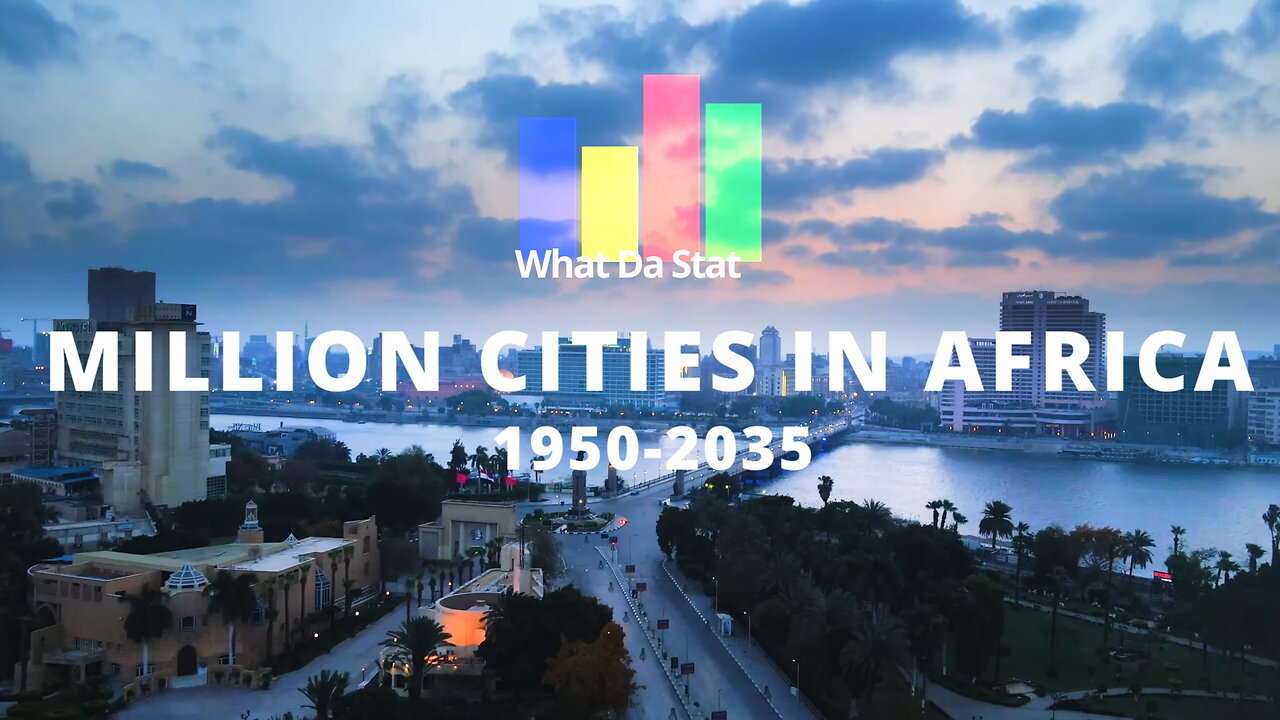Premium Only Content

Million Cities in Africa 1950-2035
This video shows cities in Africa with over one million urban population, and Africa's urbanization in percentage and total urban population, from 1950 to projected in 2035. Countries and their flags are shown as they exist today.
The urbanization trend in Africa has witnessed significant growth since 1950, leading to the emergence of numerous cities with populations exceeding one million.
Many African cities experienced rapid population growth since 1950 due to factors such as rural-urban migration, natural population increase, and economic development. This growth has led to the expansion and densification of urban areas.
Over the decades, several megacities (cities with populations exceeding 10 million) have emerged in Africa, including Lagos (Nigeria), Kinshasa (Democratic Republic of Congo), Cairo (Egypt), and Johannesburg (South Africa). These megacities serve as economic, cultural, and administrative hubs, attracting migrants from both within the country and abroad.
While some regions of Africa have seen rapid urbanization and the emergence of multiple large cities, others have lagged behind in urban development. Countries in North Africa, such as Egypt and Algeria, have relatively higher urbanization rates compared to those in Sub-Saharan Africa, where urbanization has been slower but steadily increasing.
The rapid urbanization of African cities has often outpaced the development of infrastructure, leading to challenges such as inadequate housing, limited access to clean water and sanitation, congestion, and inadequate transportation systems. Informal settlements, characterized by makeshift housing and limited access to basic services, are prevalent in many African cities.
African cities with large populations play crucial roles in their countries' economies, serving as centers for trade, finance, manufacturing, and services. They attract investments, skilled labor, and entrepreneurial activities, contributing significantly to national and regional economic growth.
Despite the challenges, many African governments and municipalities have embarked on urban planning initiatives to manage urban growth effectively, improve infrastructure, and enhance livability. However, implementation often faces constraints such as limited financial resources, institutional capacity, and governance issues.
Urbanization in Africa is expected to continue in the coming decades, driven by factors such as population growth, rural-urban migration, and economic development. This trend will necessitate concerted efforts to address infrastructure deficits, promote sustainable urban development, and enhance the quality of life for urban residents.
Overall, the urbanization of African cities with populations exceeding one million since 1950 reflects the continent's dynamic demographic, economic, and social transformations, presenting both opportunities and challenges for policymakers, urban planners, and residents alike.
Data sources and projections: World Bank and UN
Music: Blue Crystal Star - Eternity https://soundcloud.com/crystalblue64/serinity
Data visualization created with flourish.studio https://flourish.studio
-
 1:06:42
1:06:42
The Connect: With Johnny Mitchell
2 days ago $10.96 earnedTruth About The Epstein Files: CIA Agent Reveals The Connection Between The Mossad, Epstein, & Trump
40.6K33 -
 LIVE
LIVE
FyrBorne
13 hours ago🔴Warzone M&K Sniping: I Have An Eye for Destruction
126 watching -
 LIVE
LIVE
IamNibz
4 hours ago $0.63 earnedWhat's A Lord Compared To A God?
127 watching -
 LIVE
LIVE
tacetmort3m
8 hours ago🔴 LIVE - STILL NO PATCH, FUNCOM? - DUNE AWAKENING DAY 18
52 watching -
 3:55:35
3:55:35
Badlands Media
23 hours agoThe Narrative Ep. 30: Patriot Games
117K32 -
 2:34:45
2:34:45
Matt Christiansen
14 hours agoBondi v Bongino Epstein Debacle, CA Weed Farm ICE Raid, Guest Liberty Doll | MC Live 7/13/25
50.9K47 -
 2:27:02
2:27:02
TheSaltyCracker
13 hours ago1 Year Ago Today ReEEeStream 7-13-25
169K406 -
 1:11:43
1:11:43
Sarah Westall
17 hours agoHow Long will Humans Live? Immortal Reproductive Cells, Future of Anti-Aging w/ Dr. Bill Andrews
70.7K11 -
 7:32:32
7:32:32
SpartakusLIVE
13 hours agoLAST CHANCE for Spartakus' Loadouts w/ ADVANCEDgg || 25% off! - Code "Spartakus"
79K1 -
 4:35:37
4:35:37
EricJohnPizzaArtist
6 days agoAwesome Sauce PIZZA ART LIVE Ep. #54: I WANT MY PUDGE TV!
72.4K4